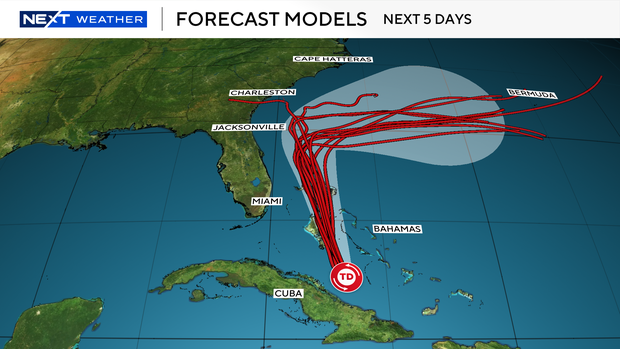MIAMI, FL – The time for speculation is over. The disorganized tropical wave that vexed forecasters for days has explosively transformed into Tropical Storm Imelda, a rapidly organizing system that the National Hurricane Center (NHC) now warns is on a trajectory for catastrophic impact on the United States.
The latest reconnaissance data from hurricane hunter aircraft reveals a storm quickly building a formidable core, with sustained winds now at 60 mph. The NHC has issued an urgent hurricane update, stating there is a high probability Imelda will become a major hurricane—Category 3 or higher—before making landfall.
Anatomy of a Supercharged System
Imelda is not just a typical tropical storm; it is a system feeding on a perfect storm of atmospheric and oceanic conditions primed for explosive intensification. This process, known as rapid intensification, is defined as an increase in wind speed of at least 35 mph in 24 hours, and Imelda has all the ingredients to achieve it.
The storm is traversing a deep pool of the Atlantic's warmest waters, known as the Gulf Stream. This high-octane rocket fuel provides the thermal energy necessary for the storm's engine to roar to life, a critical factor detailed in every technical brief from the NOAA hurricane center.
Atmospheric Engine
Beyond the warm water, the atmospheric environment is dangerously favorable. Vertical wind shear, the enemy of developing cyclones, is exceptionally low, allowing Imelda's vertical structure to align and strengthen without disruption.
Furthermore, the storm is embedded in a deep plume of tropical moisture. This prevents dry air from infiltrating its core and weakening the convection, allowing thunderstorms to build unimpeded around its developing eye.
Forecasting on a Knife's Edge
The "Imelda spaghetti models" remain a source of intense focus, but a grim consensus is beginning to emerge. The notorious divergence between the American (GFS) and European (ECMWF) models is narrowing, and the picture it paints is terrifying.
Both premier models now project a powerful hurricane making a direct assault on the Southeast coast. The primary difference now lies in the storm's forward speed at landfall, a critical detail that will determine the severity of the inland flooding threat.

The latest spaghetti models show an alarming convergence, drastically increasing confidence in a high-impact event for the Carolinas and Georgia and reducing the odds of a harmless turn out to sea.
Stall Scenario a Nightmare Realized
The gravest concern among NHC forecasters is the high probability that Imelda will stall or slow to a crawl as it approaches the coast. This is caused by a collapsing steering ridge to the north, effectively leaving the powerful hurricane with nowhere to go for 24 to 48 hours.
This scenario is reminiscent of Hurricane Florence in 2018, which produced catastrophic, record-shattering rainfall and flooding far inland. As analysts have noted in their historical reviews, these "stalling" storms are often far deadlier due to water than wind.
Threat Matrix
The official Imelda path from the NHC requires a forensic interpretation. The threat is not just a point on a map but a wide swath of interconnected dangers that will extend for hundreds of miles.
Storm Surge
A major hurricane making landfall on the concave coastline of the Carolinas is a recipe for a catastrophic storm surge. Projections indicate a potential surge of 9 to 13 feet above normal tide levels, capable of inundating entire communities and reshaping the coastline permanently.
Inland Flooding
With the stall scenario likely, rainfall totals are expected to be measured in feet, not inches. Widespread totals of 15 to 25 inches are forecast, with isolated amounts potentially exceeding 35 inches. This will lead to life-threatening flash flooding and river flooding that will persist for weeks after the storm has passed, a point emphasized in briefings reported by news agencies.
The Human Element
The focus on the tropical update for Imelda is happening against the backdrop of an already menacing Atlantic. Far out at sea, Hurricane Humberto's terrifying intensification into a Category 5 monster serves as a violent testament to the potential lurking in the ocean.
While Humberto poses no threat to the United States, its rapid development is a case study that has meteorologists deeply concerned about Imelda's potential. Bermuda remains on alert, a situation being tracked by a global audience, with international outlets providing critical context.
A Volatile and Dangerous Peak Season
The NOAA forecast for an above-average season is now becoming a stark reality. A quiet summer has given way to an explosive and dangerous peak, confirming that the most perilous period of the 2025 season is underway.
The time for passive monitoring is over. The analysis from a spectrum of viewpoints, including the logistical and emergency response angles detailed by various sources, underscores that immediate action is required to save lives. You can access live data and deeper analysis on the season's trajectory at NewsIQ's storm tracker hub.
This is a life-threatening weather emergency unfolding in real-time. For unparalleled, cutting-edge revelations and live-pulse updates that deliver the unvarnished truth necessary for critical decision-making, unlock your edge today at NewsIQ.




